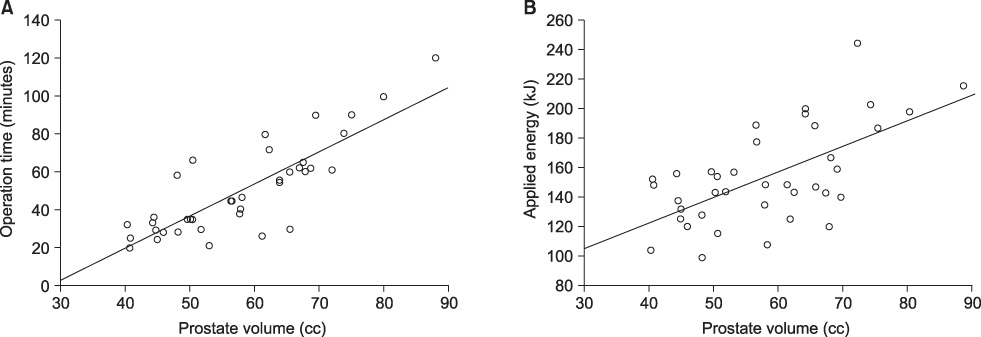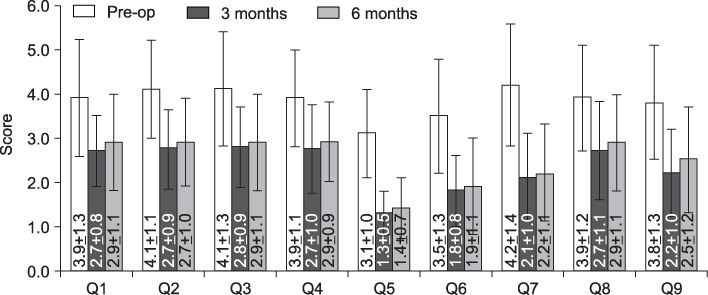Korean J Urol.
2007 Sep;48(9):956-964. 10.4111/kju.2007.48.9.956.
Evaluation of the Quality of Life and the Efficacy of Treatment after High Power Potassium-titanyl-phosphate(KTP) Laser Vaporization for Patients with a Prostate Volume Greater than 40cc
- Affiliations
-
- 1Department of Urology, College of Medicine, Korea University, Seoul, Korea. jjkim98@korea.ac.kr
- KMID: 2061298
- DOI: http://doi.org/10.4111/kju.2007.48.9.956
Abstract
- PURPOSE
This study was conducted to evaluate the quality of life and efficacy of treatment after 80 watts high power potassium-titanyl-phosphate laser vaporization for patients with a prostate volume greater than 40cc. We adopted the benign prostatic hyperplasia(BPH) quality of life (QoL)-K1 short form that was developed by the Korean Urological Association in 2001 to more accurately assess the quality of life of patients with BPH.
MATERIALS AND METHODS
From July 2005 to March 2006, we performed KTP laser vaporization on a total of 38 patients with symptomatic benign prostatic hyperplasia of the prostate and all their prostate volumes were more than 40cc. All the patients were evaluated preoperatively and then again at 3 and 6 months postoperatively based on the International Prostate Symptom Score(IPSS), the maximum urinary flow rate(Qmax) and the postvoid residual urine(PVR). We conducted a survey of all the patients regarding BPH with using the QoL-K1 short form by means of mail and phone at a mean of 8.7 months(range: 5-12) postoperatively.
RESULTS
The mean operation timewas 50.5 minutes(range: 20-120), and the mean duration of admission and catheterization were 2.9+/-0.4 days and 22.0+/-10.9 hours, respectively. The mean total score for the BPH QoL-K1 short form improved from 34.5 preoperatively to 22.5 at 6 months postoperatively(p<0.001). There was a significant improvement in the IPSS, Qmax and PVR after the operation, but there were no differences between these parameters at 3 months and 6 months after KTP laser vaporization. There was dysuria in 9(24%) patients postoperatively and urinary tract infection occurred in 10(26%) of all the patients.
CONCLUSIONS
This study showed that KTP laser vaporization was effective in patients with a prostate volume more than 40cc, and the procedure produced improvements in the IPSS, Qmax,PVR and the BPH QoL-K1 short form. Despite the high rate of dysuria and urinary tract infection, the patients treated with KTP laser showed satisfaction about the operation because of the shortened duration of both admission and catheterization.
MeSH Terms
Figure
Cited by 1 articles
-
Comparative Analysis of the Efficacy and Safety of Photoselective Vaporization of the Prostate for Treatment of Benign Prostatic Hyperplasia according to Prostate Size
Ju Hyun Park, Hwancheol Son, Jae-Seung Paick
Korean J Urol. 2010;51(2):115-121. doi: 10.4111/kju.2010.51.2.115.
Reference
-
1. Perrin P, Barnes R, Hadley H, Bergman RT. Forty years of transurethral prostatic resections. J Urol. 1976. 116:757–758.2. Mebust WK, Holtgrewe HL, Cockett AT, Peters PC. Transurethral prostatectomy: im-mediate and postoperative complications. A cooperative study of 13 participating institutions evaluating 3,885 patients. J Urol. 1989. 141:243–247.3. Borboroglu PG, Kane CJ, Ward JF, Roberts JL, Sands JP. Immediate and postoperative complications of transurethral prostatectomy in the 1990's. J Urol. 1999. 162:1307–1310.4. Bouchier-Hayes DM, Anderson P, Van Appledorn S, Bugeja P, Costello AJ. KTP laser versus transurethral resection: early results of randomized trial. J Endourol. 2006. 20:580–585.5. Hwang EC, Joo JS, Min KD, Oh BR, Kang TW, Kwon DD, et al. A short-term comparative study on efficacy and safety of standard transurethral resection and high power (80W) potassium-titanyl-phosphate laser vaporization of the prostate. Korean J Urol. 2005. 46:1251–1255.6. Sandhu JS, Ng C, Vanderbrink BA, Egan C, Kaplan SA, Te AE. High-power potassium-titanyl-phosphate photoselective laser vaporization of prostate for treatment of benign prostatic hyperplasia in men with large prostates. Urology. 2004. 64:1155–1159.7. Lukacs B, Comet D, Grange JC, Thibault P. Construction and validation of a short-form benign prostatic hypertrophy healthrelated quality-of-life questionnaire. BPH Group in General Practice. Br J Urol. 1997. 80:722–730.8. Hong JE, Choi HY, Hong SJ, Chung MK, Ahn TY, Rim JS, et al. Construction of a short form BPH specific health related quality of life scale: reliablility and validity tests. Korean J Urol. 2001. 42:1270–1277.9. Rutkow IM. Urological operations in the United States: 1979 to 1984. J Urol. 1986. 135:1206–1208.10. McConnell JD, Barry MJ, Bruskewitz RC. Benign prostatic hyperplasia: diagnosis and treatment. Agency for Health Care Policy and Research. Clin Pract Guidel Quick Ref Guide Clin. 1994. 8:1–17.11. Kuntz RM. Current role of lasers in the treatment of benign prostatic hyperplasia. Eur Urol. 2006. 49:961–969.12. Blute ML, Tomera KM, Hellerstein DK, McKiel CF Jr, Lynch JH, Regan JB, et al. Transurethral microwave thermotheraphy for management of benign prostatic hyperplasia results of the United Utates Prostatron Cooperative Study. J Urol. 1993. 150:1591–1596.13. Kaplan SA, Te AE. Transurethral electrovaporization of the prostate: a novel method for treating men with benign prostatic hyperplasia. Urology. 1995. 45:566–572.14. Jacques SL. Laser-tissue interactions. Photochemical, photothermal, and photomechanical. Surg Clin North Am. 1992. 72:531–535.15. Te AE. The development of laser prostatectomy. BJU Int. 2004. 93:262–265.16. Malek RS, Kuntzman RS, Barrett DM. Photoselective potassium-titanyl-phosphate laser vaporization of the benign obstructive prostate: observations on long-term outcomes. J Urol. 2005. 174:1344–1348.17. Reich O, Bachmann A, Siebels M, Hofstetter A, Stief CG, Sulser T. High power (80W) potassium-titanyl-phosphate laser vaporization of the prostate in 66 high risk patients. J Urol. 2005. 173:158–160.18. Te AE, Malloy TR, Steins BS, Ulchaker JC, Nseyo UO, Hai MA. Impact of prostate-specific antigen level and prostate volume as predictors of efficacy in photoselective vaporization prostatectomy: analysis and results of an ongoing prospective multicentre study at 3 years. BJU Int. 2006. 97:1229–1233.19. Roehrborn CG, McConnell JD, Lieber M, Kaplan S, Geller J, Malek GH, et al. Serum prostate-specific antigen concentration is a powerful predictor of acute urinary retention and need for surgery in men with clinical benign prostatic hyperplasia. Urology. 1999. 53:473–480.20. Roehrborn CG. Meta-analysis of randomized clinical trials of finasteride. Urology. 1998. 51:Suppl 4A. 46–49.21. Cho JS, Kim CI, Seong DH, Kim HS, Kim YS, Kim SJ, et al. Cut-off point of large prostate volume for the patients with benign prostatic hyperplasia. Korean J Urol. 2005. 46:1246–1250.22. Hunter DJ, McKee M, Black NA, Sanderson CF. Health status and quality of life of British men with lower urinary tract symptoms: results from the SF-36. Urology. 1995. 45:962–971.23. Volkan T, Ihsan TA, Yilmaz O, Emin O, Selcuk S, Koray K, et al. Short term outcomes of high power (80W) potassium-titanyl-phosphate laser vaporization of the prostate. Eur Urol. 2005. 48:608–613.24. Bachmann A, Ruszat R, Wyler S, Reich O, Seifert HH, Műller A, et al. Photoselective vaporization of the prostate: the basel experience after 108 procedures. Eur Urol. 2005. 47:798–804.
- Full Text Links
- Actions
-
Cited
- CITED
-
- Close
- Share
- Similar articles
-
- The Effectiveness of Transurethral Resection of the Prostate Combined with High Power Potassium-titanyl-phosphate(KTP) Laser Vaporization for Patients with a Prostate Volume Greater than 45cc
- The One Year Outcome after KTP Laser Vaporization of the Prostate According to the Calculated Vaporized Volume
- Changes in Serum Prostate-Specific Antigen Levels after Potassium-Titanyl-Phosphate (KTP) Laser Vaporization of the Prostate
- A Short-term Results on Efficacy and Safety of High Power (80W) KTP (Potassium-Titanyl-Phosphate) Laser Vaporization of the Prostate
- Impact of Prostate Volume on the Efficacy of High-Power Potassium-Titanyl-Phosphate Photoselective Vaporization of the Prostate: A Retrospective, Short-Term Follow-Up Study on Evaluating Feasibility and Safety



